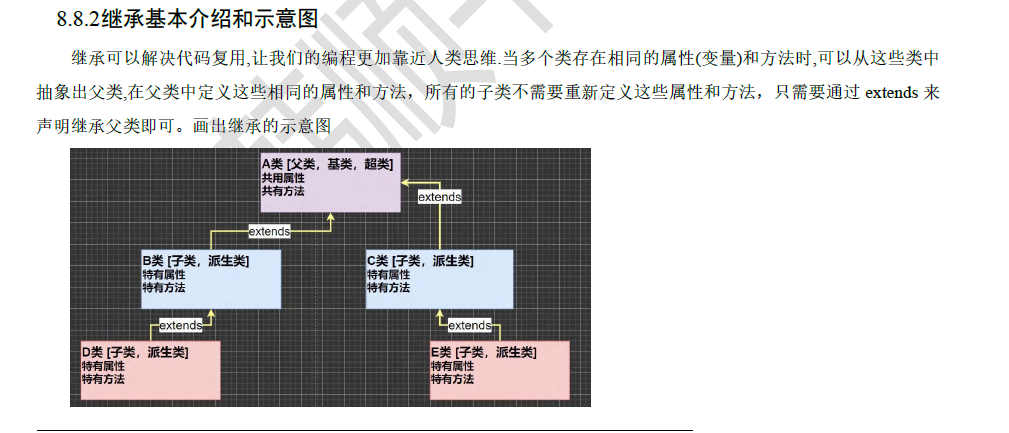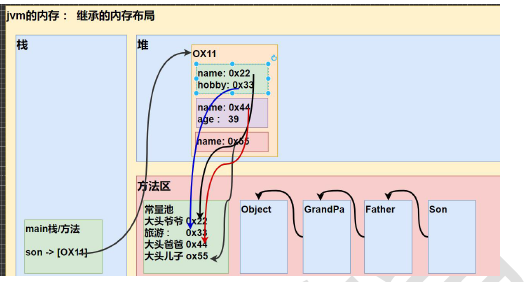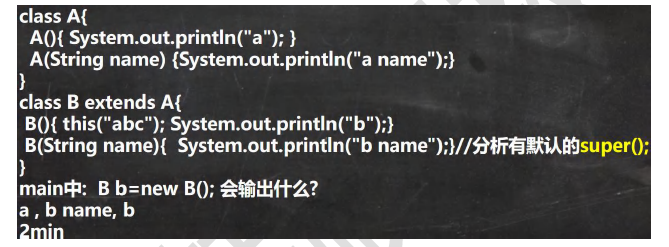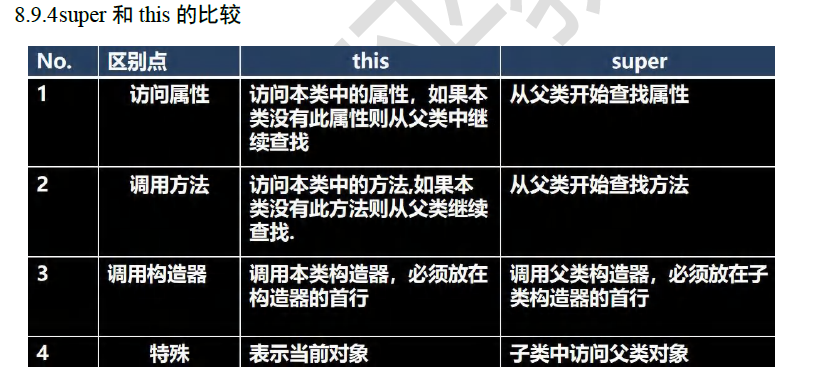P284-继承P289Super关键字P302覆盖P306-P311多态
P284无参数构造器与setXxx()方法集合练习1
package Encap;
public class Person {
public static void main(String[] args) {
Person1 p1 = new Person1();
p1.setName("javakkkk");
p1.setAge(200);
p1.setSalary(9999);
System.out.println(p1.info());
Person1 p2 = new Person1("simi",400,999);//利用构造器指定属性
System.out.println(p2.info());
}
}
class Person1{
public String name;
private int age;
private double salary;
public Person1(String name, int age, double salary) {//有三个属性的构造器
this.name = name;//如果是单独构造器就不具备setX()的作用
this.age = age;
this.salary = salary;
//所以我们可以将set方法写入构造器
setName(name);
setAge(age);
setSalary(salary);
}
public Person1() {
}
public int getAge(){
return age;
}
public void setAge(int age){
if(age <1 || age > 120){
System.out.println("年龄需在1-120");
this.age=20;
}else{
this.age=age;
}
}
public void setName(String name) {
if(name.length() >= 6 || name.length() <=2 ){
System.out.println("名字长度不对,需要2-6");
this.name="null";
}else {
this.name = name;
}
}
public double getSalary(int a) {//可以增加对象的权限判断
return a != 666 ? 0:salary;
}
public void setSalary(double salary) {
this.salary = salary;
}
public String info(){
return("name= "+name+" age= "+age+" salary= "+salary);
}
}
P285练习
package Encap;
public class Acount {
private String name;
private double balance;
private String pwd;
public Acount() {
}
public Acount(String name, double balance, String pwd) {
this.setName(name);
this.setBalance(balance);
this.setPwd(pwd);
}
public void setName(String name) {
if(name.length() > 4 || name.length() < 2){
System.out.println("name在2-4位");
this.name="无名";
}else {
this.name = name;
}
}
public String getName() {
return name;
}
public double getBalance() {
return balance;
}
public void setBalance(double balance) {
if(balance > 20.0) {
this.balance = balance;
}else{
System.out.println("balance > 20,否则默认为0");
this.balance=0.0;
}
}
public String getPwd() {
return pwd;
}
public void setPwd(String pwd) {
if( pwd.length() == 6) {
this.pwd = pwd;
}else{
System.out.println("密码必须为6位,否则默认000000");
this.pwd="000000";
}
}
public void info(){
System.out.println("name= "+name +" balance= "+balance +" pwd= "+pwd);
}
}
package Encap;
public class AcountTest {
public static void main(String[] args) {
Acount acount = new Acount();
acount.setPwd("1234567");
acount.setBalance(9);
acount.setName("lllll");
acount.info();
}
}
P286继承
1.由于两个类许多属性和方法相同,所以需要继承

-----
2.继承的规则

-----
3.代码
package com.extend;
//源类
public class Student {
public String name;
public int age;
private double score;
public void setScore(double score) {
this.score = score;
}
public void showinfo(){
System.out.println("学生 "+name +" age "+age+" score "+score);
}
}
package com.extend;
//让pupil继承student
public class Pupil extends Student {
public void testing(){
System.out.println("小学生 "+name+" testing");
}
}
package com.extend;
//让graduate继承student
public class Graduate extends Student {
public void testing(){
System.out.println("大学生 "+name+" testing");
}
}
package com.extend;
public class TestEx {//测试调用
public static void main(String[] args) {
Pupil p = new Pupil();
p.name="Ada";
p.age=10;
p.testing();
p.setScore(100);
p.showinfo();
System.out.println("=========");
Graduate g = new Graduate();
g.name="Beta";
g.age=99;
g.testing();
g.setScore(150);
g.showinfo();
}
}
4.继承细节

-
package com.extend;
//源类(个人比较喜欢叫源类)
public class Student {
public int n1=100;
protected int n2=200;
int n3=300;
private int n4=400;
public Student() {//无参构造器
System.out.println("源类Student()构造器被调用");
}
public int getNe(){//源类提供一个公公共方法去访问n4
return n4;
}
public void calltest400(){
test400();
}
public void test100() {
System.out.println("test100");
}
protected void test200(){
System.out.println("test200");
}
void test300(){
System.out.println("test300");
}
private void test400(){
System.out.println("test400");
}
}
package com.extend;
//让graduate继承student
public class Graduate extends Student {
public Graduate() {
super();//默认调用父类的无参构造器,写不写都可以
system.out.println("子类Graduate()构造器被调用")
}
public void sayOK(){//子类的方法
// 非私有的属性和方法在子类中可以直接访问,私有要通过公共方法去访问
System.out.println(n1+n2+n3);//不能访问n4,不能访问test400();
test100();
test200();
test300();
//源类提供的公共方法去访问
System.out.println("n4="+getNe());
calltest400();
}
}
package com.extend;
public class TestEx {//测试调用
public static void main(String[] args) {
Graduate g = new Graduate();
g.sayOK();
}
}
输出
源类Student()构造器被调用
子类Graduate()构造器被调用
600 test100 test200 test300 n4=400 test4

-具体可见上层述代码,源类构造器先调用,再调用子类的构造器

-
第一句话理解(注意此时源类只有一个无参构造器)
package com.extend;
//让graduate继承student
public class Graduate extends Student {
public Graduate() {
System.out.println("子类的无参构造器被调用");
}
public Graduate(int n3){
System.out.println("子类构造器int n3被调用()");//源类不变,增加一个构造器
}
package com.extend;
public class TestEx {//测试调用
public static void main(String[] args) {
Graduate g = new Graduate();
System.out.println("第二个对象");
Graduate g2 = new Graduate(3000);
g.sayOK();
g2.sayOK();
}
}
输出结果为
父类Student()无参构造器调用 子类的无参构造器被调用 第二个对象 父类Student()无参构造器调用 子类构造器int n3被调用() 600 test100 test200 test300 n4=400 test400 600 test100 test200 test300 n4=400 test400
第二句话理解(此时源类有Student(int 1,int2)构造器,将默认构造器覆盖了)
public class Student {
public int n1=100;
protected int n2=200;
int n3=300;
private int n4=400;
//public Student() {//无参构造器
// System.out.println("父类Student()无参构造器调用");
//}
public Student(int n1,int n2){
System.out.println("源类Student(int n1,int n2)构造器被调用了");
}
package com.extend;
//让graduate继承student
public class Graduate extends Student {
public Graduate() {
super(100,200);
System.out.println("子类的Graduate构造器被调用");
}
public Graduate(int n3){
super(100,200);
System.out.println("子类构造器Graduate(int n3)被调用()");
}
输出结果为
源类Student(int n1,int n2)构造器被调用了 子类的Graduate构造器被调用 第二个对象 源类Student(int n1,int n2)构造器被调用了 子类构造器Graduate(int n1,int n2)被调用()

如果调用源类可以什么都不写,或者super();如果参数,比如name,super("jack");

--
可以在ctrl+H察看类的关系
5.继承本质的分析(theoray原理)
package com.extend;
public class Theoray {
public static void main(String[] args) {
D d = new D();
System.out.println(d.name+d.age+d.hobby);
}
}
class G{
String name="姥姥";
String hobby="money";
}
class M extends G{
String name="mon";
int age =45;
}
class D extends M{
String name="dau";
}

-
顺序:
1.new D,继承关系Object-G-M-D,所以从D-M-G-O
2.对象在栈——在堆----方法区常量值存储String 类型数据
3.当访问D.属性的时候,先看子类是否有这个属性,如果有并且可以访问,则访问。
(上文说过如果私有变量可以通过父类方法进行访问
class M extends G{
String name="mon";
private int age =45;
public int getAge() {
return age;
}
//在System.out.println(d.name+d.getAge()+d.hobby);
注意一个点,上文比如我调用d.age,比如G和M都有age,M是私有,G是公有的,实际上不会调用,因为在M已经堵住了,有顺序的,所以不会继续调用G的age属性)
如果子类没有这个属性,就看源类继续上一级
依次输出 dau45money
6.面向对象的编程继承练习

-
分析:B(){this("abc")执行下面构造器,然后返回A的无参构造器
练习2
public class Computer {
private String cpu;
private int memory;
private int disk;
public Computer(String cpu, int memory, int disk) {
this.cpu = cpu;
this.memory = memory;
this.disk = disk;
System.out.println("调用C(1,2,3)构造器");
}
public String getDetial(){
return "cpu="+cpu+" memory="+memory+" disk="+disk;
}
}
package com.extend;
public class PC extends Computer{
private String band;
public PC(String cpu, int memory, int disk, String band) {
//IDEA根据继承的思想,父类继承的初始化
//子类构造器完成子类属性的初始化
super(cpu, memory, disk);
this.band = band;
}
public void printInfo(){
System.out.println(getDetial()+"brand= "+band);
//通过父类的方法得到信息
}
}
package com.extend;
public class NotePad extends Computer {
private String color;
public NotePad(String cpu, int memory, int disk, String color) {
super(cpu, memory, disk);
this.color = color;
}
public void Printinfo(){
System.out.println(getDetial()+"color="+color);
}
}
package com.extend;
public class Test {
public static void main(String[] args) {
PC pc = new PC("intel",4,5,"IBM");
pc.printInfo();
System.out.println("====第二个对象===");
NotePad nP = new NotePad("tian",7,8,"blue");
nP.Printinfo();
P289Super关键字

--
public class A{
public int a;
private String b;
double c;
public A() {
}
public A(int a) {
this.a = a;
}
public A(int a, String b, double c) {
this.a = a;
this.b = b;
this.c = c;
}
public void Testa(){
}
private void Testb(){
}
}
public class B extends A{
public int d;
public void Test(){//调用父类的属性非private
System.out.println(super.a+super.c);
}
public void OK(){//调用父类的方法,非private
super.Testa();
}
public B(){
// super ();继承无参构造器
super (10);//调用的是父类的构造器,public A(int a)
}
}

-
package Super;
public class A {
public int a;
private String b;
double c;
public A(int a, String b, double c) {
this.a = a;
this.b = b;
this.c = c;
}
public void Testa(){
}
}
class B extends A{
public int d;
public void OK(){//调用父类的方法,非private
//当想要调用父类中的Testa()方法的时候,有三种方式
//Testa();
//找此方法的时候,顺序是先找本类,
// 本类有再并且可以调用,则调用,
// 无则找父类,一直找,直到Object类
// 如果在过程中找到但不可访问则报错,或者方法不存在
// this.Testa();//等价上述的Testa()
super.Testa();//跳过子类(如果子类有同样名字的方法或者没有都会跳过)
//是直接找父类的Testa(),后面步骤和上一样直到Object类
//演示调用属性的规则,同上
System.out.println(a);
System.out.println(this.a);
System.out.println(super.a);
}

-
P302方法重写/覆盖(override)

``
不一定是父子关系,只是相对而言,比如A-B-C,A-C之间也有可能

-
重写可以通过编译,比如B继承A,父类返回类型A,子类返回类型可以为A也可以为B
注意,子类的范围不能缩小

-
补充一下,重载的形参可以是普通参数+可变参数,可变参数放在最后且一个形参只能一个可变参数P235
练习code
package com;
public class Person {
private String name;
private int age;
public Person(String name, int age) {
this.name = name;
this.age = age;
}
public String say(){//注意为了简洁,没有写set()和get()方法
return "name= "+name+"age= "+age;
}
}
public class Student extends Person {
private int id;
private int score;
public Student(String name, int age, int id, int score) {
super(name, age);
this.id = id;
this.score = score;
}
public String say(){//此时属于方法重写了
return super.say()+" id="+id+" score="+score;
}
public void setScore(int score) {
this.score = score;
}
}
package com;
public class OverdideExercise {
public static void main(String[] args) {
Person p1 = new Person("Pp",9);
System.out.println(p1.say());
System.out.println("第二个对象");
Student s = new Student("Ss",20,6666,99);
System.out.println(s.say());
}
}
P306多态polymorphic

--

---
2)对象的多态
上图 父类发引用 Anima; animal ,指向,子类的对象 new Dog();
package com.Polymoraphic.Exercise;
public class Animal {//父类
public void cry(){
System.out.println("A在叫");
}
}
package com.Polymoraphic.Exercise;
public class Dog extends Animal {//子类1
public void cry(){
System.out.println("dog瞎叫");
}
}
package com.Polymoraphic.Exercise;
public class Cat extends Animal//子类2
public void cry(){
System.out.println("cat在叫");
}
}
package com.Polymoraphic.Exercise;
public class Test {
public static void main(String[] args) {
//体验对象的多态特点
Animal animal= new Dog();//注意 Dog是Animal的子类才可以
animal.cry();//因为运行时, 执行到该行时,animal
// 运行类型是Dog,所以cry 就是Dog 的cry
animal = new Cat();//编译还是animal,but 运行类型是Cat
//运行的时候看的是堆里的指向
animal.cry();
}
}
public void feed(Animal animal,Food food){
\\ animal的编译类型是Animal ,可以指向接收Animal子类的对象
system.out.println(animal.getName +feed.getName)
}
P310多态的注意事项和细节

向上引用 例如上文 A nimal animal = new Dog();code为举例
package com.Polymoraphic.Exercise;
public class Animal {
public void eat(){
System.out.println("A在eat");
}
public void run(){
System.out.println("A在run~");
}
public void sleep(){
System.out.println("A在sleep~");
}
}
package com.Polymoraphic.Exercise;
public class Cat extends Animal{
public void eat (){
System.out.println("cat在eat");
}
public void catchM () {
System.out.println("cat抓老鼠");
}
}
package com.Polymoraphic.Exercise;
public class Test {
public static void main(String[] args) {
//向上转型,父类的引用指向子类的对象
Animal animal=new Cat();
//Object object = new Cat();也可以
//可以访问父类中的所有成员(需遵守访问权限,比如private)
/*但是不能访问子类的特有成员ainimal.catch
因为在编译阶段,能调用哪些成员,由编译类型来决定
*/
//最终运行效果看子类的具体实现,调用方法的时候从子类开始查找,规则与方法调用规则一致
animal.eat();//cat在eat
animal.run();//A在run~
animal.sleep();//A在sleep~
}
}

向下转型
package com.Polymoraphic.Exercise;
public class Test {
public static void main(String[] args) {
//向上转型,父类的引用指向子类的对象
Animal animal=new Cat();
//向下转型,语法 子类类型 引用名=(子类类型)父类引用
//此时编译类型Cat,运行类型也是Cat
//(2)要求父类的引用必须指向的是当前目标类型的对象
//意思是下行的animal实际上指向Cat对象,cat1也指向Cat对象
//原本的时候animal>Animal,cat1>Cat对象
//把指向猫的animal转向cat
Cat cat1 = (Cat) animal;
cat1.catchM();//调用这个方法,得到猫类的特有方法
Animal animal1 = new Dog();
Dog dog = (Dog) animal1;//个人认为多态的向下需要向上
// 使得父类的引用指向当前目标类型的对象
dog.cry();
}






















 327
327











 被折叠的 条评论
为什么被折叠?
被折叠的 条评论
为什么被折叠?








